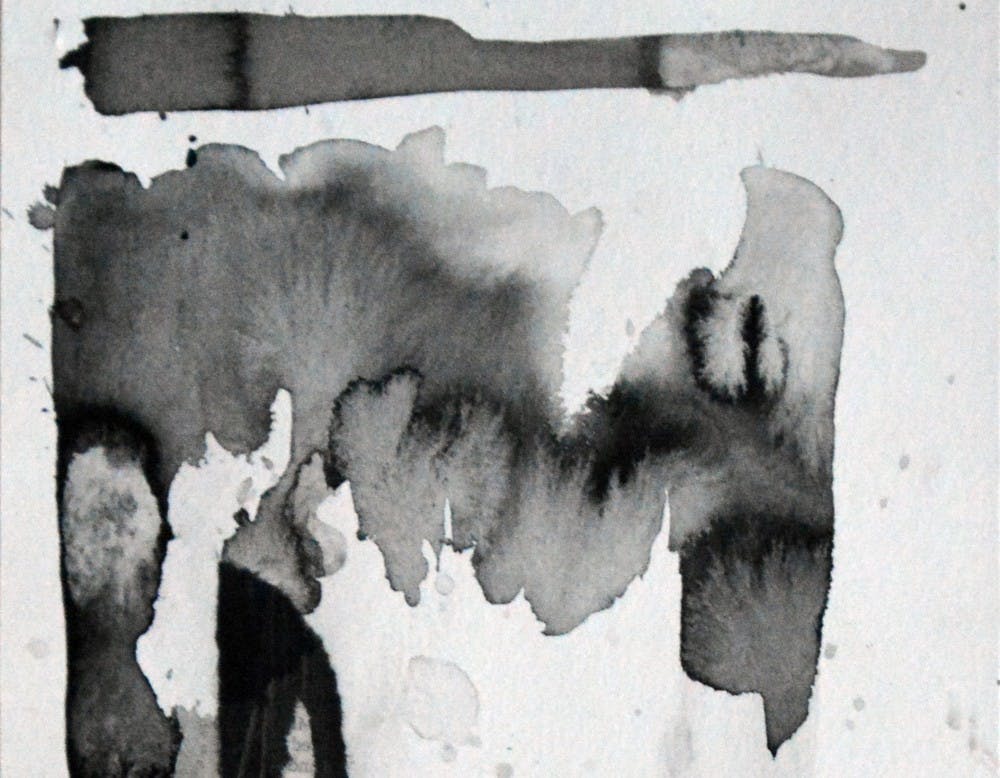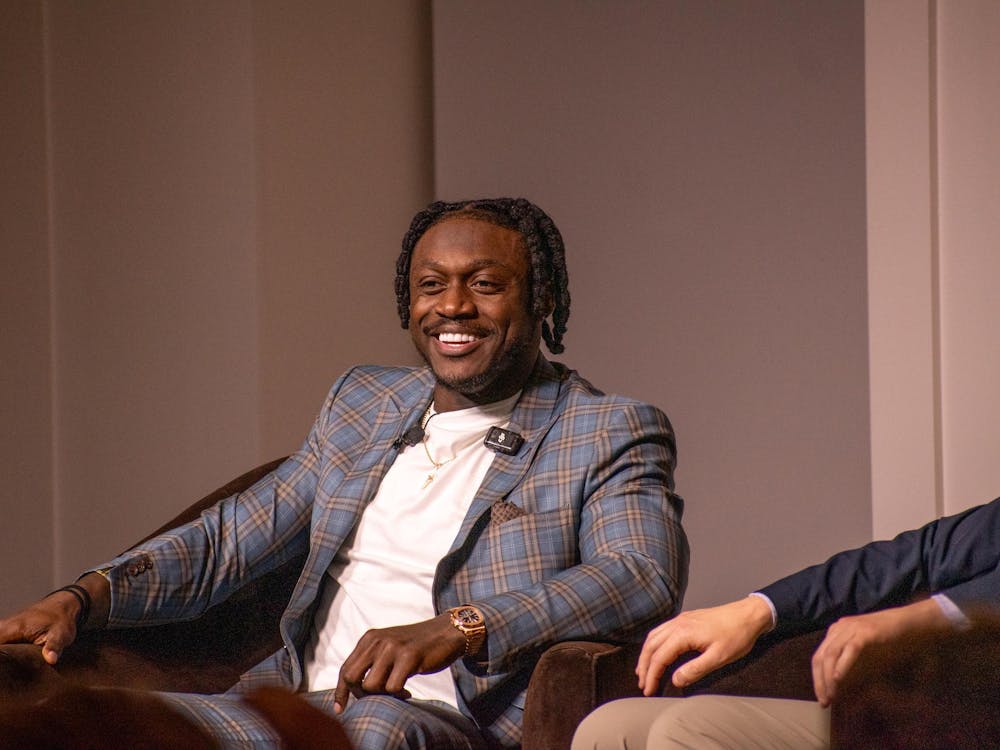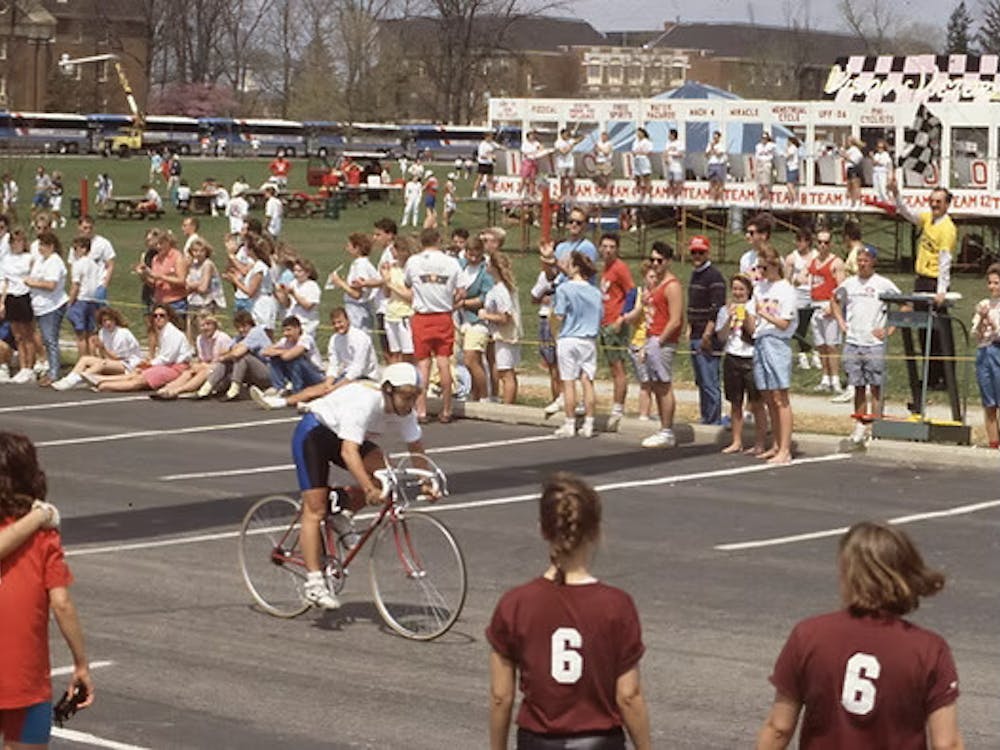"I really need to stop wearing my sorority clothes to this class," she said, narrowly dodging another murky splash. Although the sink's basin was deep, the smooth curves of her speckled palette provided the perfect bounce board up to her sleeves.
It was true. Abby Murray's gray Kappa Alpha Theta sweater had no business as a smock. Although she considered herself an artist, painting wasn't Abby's strong suit. She preferred the stage.
The rest of the class roster was comprised of 13 other theatre majors and minors. All are actors, not painters. So for most of the class, Abby and me included, the visual arts are a new frontier.
We all knew this class would hone our directing skills and we appreciated the instructor's occasional connections to lighting arrangements or set design, but it was not uncommon for the visual arts class to feel like a waste of energy.
Regardless of theatrical interests, the course was required. It didn't matter if we could barely color within the lines. There were no exemptions.
Painting was especially terrifying, as the permanence of acrylics caused most of us to cringe with every brush stroke. Mistakes when drawing could be corrected with an eraser, but paint was less forgiving.
To our credit, we had come a long way in four weeks. At first the weekly projects seemed increasingly daunting, the students hesitant to make a single mark in our sketchpads. But with each completed challenge came a boost in collective confidence.
A scrappy gallery of previous projects hung around the upstairs studio as a testament to our progress, reminding us of our newfound mastery of construction paper. Despite open windows, the stubborn smell of rubber cement lingered in the air.
At the helm of the class stood Gion DeFranseco, ready to soothe the impending panic from his next lesson. His gray tinted beard clashed with his bald sheen, the two evenly divided by a thick pair of glasses that framed the artist's eyes.
Gion had taught the course for over a decade and was used to dealing with disengagement from young actors. This semester's crop however was proving especially troublesome.
As usual, Gion began his class with a joke.
"I have a gift for you all," he said, flinging monochrome cards across each student's desk. "I wanted to show I value you."
Enjoy what you're reading?
Signup for our newsletter
This received a lively groan from the class, as did Gion's follow up.
"Or maybe I just wanted to throw shade," he continued, smiling wide.
On each card were ten hues of gray, arranged from white to black. Each hue contained a heart-shaped hole used to compare the value of our mixtures. By placing the card over our paint and squinting, we could compare hues and make realistic shadows.
"For this project you'll need to paint some spheres," Gion said.
Abby's eyes bulged.
Painting a 2D shape was one thing. We'd reached that level of artistry before kindergarten. Spheres however required a gradient of light to look realistic, which inevitably meant a range of light to dark colored paint.
The first step was simple: draw a circle. Granted, the shape I drew looked more like an egg, but after rounding the edges I pressed forward.
Josh Romero, the lone freshman in the class, came ready to paint. He wore a blue cotton t-shirt that was more expendable than Abby's sweater.
He squirted tubes of black and white paint into his plastic palette, leaving the rest of the rainbow for later. Using his mixing brush, Josh added a dab of black to his white glob and swirled them until he had a middle gray color that looked decent on his practice piece of Bristol board.
He had a fan of paint brushes to choose from, but settled on one that was round and thin: ideal for tracing curves. With a breath, Josh dipped it in his palette before making touchdown on his canvas.
So far so good. He cleaned off his brush and added the dark black shadow. Then he covered the center of his circle. Next, he tried blending the two shades, pulling the gray into the black and vice versa, just as he'd been instructed.
No luck. His acrylic was already dry.
"Try using a bigger brush next time," suggested Gion, his chin hovering just above Josh's shoulder. "It will cover more area so you won't have that problem."
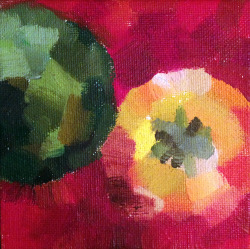
Josh nodded. Knowing how long the final composition would take to complete, he wouldn't make the same mistake with his brush choice again.
While I'd opted for a wider brush and had finished blending before my paints dried, my gradient was far from flawless.
Gion's advice for me? "Your sphere is moody."
Sure, the gradient in my sphere was a little foggy, but I doubted a sequel would show improvement. Moody was passable.
Across the room, Abby's sphere started to look coherent, but it was still nowhere close to the quality of Gion's quickfire example.
"It doesn't look so bad from a distance," Gion said.
"If you say so."
Although she was still wrestling with her art's imperfections, Abby decided she'd fix the flaws another day. After filing away her illustration board in her locker, she returned once more to the splashing sink to clean her brushes and clear her mind.
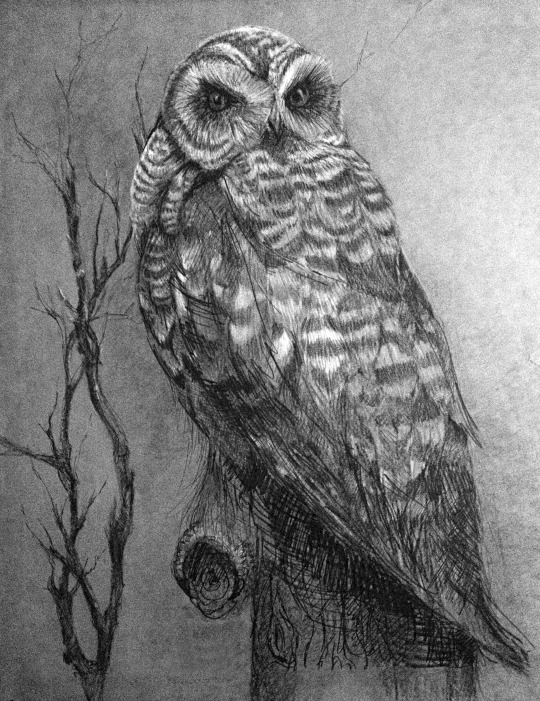
Fridays were reserved for drawing, meaning all paint brushes would be cast aside for pencils. Thank God.
After two days of painting, a shift in gears was greatly appreciated. As Gion stretched an extension cord across the floor however, it was obvious that light gradients were here to stay.
"Oh, great, we're gonna have a lamp for shading," Josh said.
"Oh, I love shading. It's my favorite," Olivia said. "It either wrecks something I draw or makes it better."
Olivia, unlike many of her fellow actors, loved to draw. A sophomore transfer student, she regularly doodled in her notebooks and had made fast friends with Gion over their shared love of squeaky cheese curds.
"I see all your newsprints out. We're excited and ready to draw, aren't we?" Gion said.
"Heck, yeah!" Olivia chimed.
Gion plugged in two lamps, then rolled a 32-gallon trash can into the center of the studio and placed a wooden baseboard across its mouth. On top of this platform he stacked boxes, a familiar drawing challenge for his pupils.
What we were not ready for was the blanket.
"Oh I love drawing fabric. It's the best," Olivia groaned. "And by the best I mean the worst."
"I can almost detect sincerity in your voice," Gion chuckled.
Draped over the stack of boxes, the silky blanket had no definitive shape of its own. Its creases and ruffles were formidable foes, as were the various balls, cylinders and pyramids that Gion placed between them.
In order to get a feel for drawing the abomination, Gion led us through some warm ups. Dividing our canvas into four quadrants, we had 60 seconds to draw the shape. When the minute was up, we'd draw it again in 45 and so on until we ran out of quadrants.
This exercise required fast thinking and broad gestures with our pencils. There was no time to question the perfection of each line, let alone each shadow.
By the end of warmups, I had the general proportion of each shape drilled into my brain. Even the blanket was a pinch less scary.
"Those are some great shapes," Gion said. "Now on to charcoal."
After unboxing my three pack of charcoal sticks from Hobby Lobby, I was struck by how gritty they felt. They were about as thick as my pencil and left a black powder on my thumb.
I snapped a stick in two, offering Olivia my other half.
Abby grimaced as she grinded her charcoal against her paper. "I hate the way it sounds."
"That's fair," Gion said. "Charcoal is very chalky."
On Gion's mark we flipped to a new page and began our first of two larger sketches, each with a 20-minute timeframe.
Right away I drew the two spheres, doing my best to capture the light sources acting on them from both sides. The charcoal would still take some getting used to, but I was at least glad I wasn't using paint.
Next I moved on to the pyramids and boxes, leaving the blanket for last.
Gion encouraged us to break down the blanket into simple triangles and squares. "It's just shapes," he repeated.
Beside me Olivia was already done with her sketch and began shading a woman's face in the corner of her page. Once happy with the woman's eyebrows, Olivia slurped up the rest of her Starbucks, using her green straw as a spoon.
The rest of the class was in a fervor, scratching in extra details until the last second.
"Alright, charcoal down," Gion said.
Finally stopping to look at my paper, I was disappointed. The spheres turned out alright, but the boxes and cylinders had wonky proportions and the blanket was unrecognizable. In my effort to highlight value difference, I had neglected to pay attention to vanishing points: the diagonal lines needed to add dimension.
Although I had a chance to try again, progress seemed unlikely.
When rehearsing for a play, every rehearsal builds on what came before, ultimately leading up to a polished final performance. I'd definitely learned from my first attempt at charcoal drawing, but as I flipped over my sketchpad to start round two, I felt like I was starting over from scratch.
"Can we rotate this thing a little more?" Abby asked. She was vying for an easier angle to sketch.
"No, don't!" Josh said, praying that his own angle wouldn't get any more difficult.
Fortune favored the freshman. Gion made some minor rearrangements to the model, but Josh and I were grateful to be facing a significantly smoother blanket.
Midway through the second sketch, Gion made his rounds again, advising me to press harder on my canvas to make a darker contrast for my shadows and eliminate some of my shapes' blurriness.
Despite my pessimism, my second drawing had crisper edges and even hinted at a 3D effect. My charcoal stick had worn down to a nub, but it was worth the sacrifice.
"I like this," Abby said. "I've never used charcoal before but I like it a lot."
The rich array of smoky shadows on her paper was impressive, far exceeding her own expectations. Gion accredited this triumph to our unusually aggressive attitude that day, a step up from our typical timidity when drawing.

"Before you go, wipe down your area with a wet paper towel to get up any charcoal dust," Gion said. "Find someone you trust and ask them if you have any charcoal on your face."
The students laughed but just to be safe I splashed my cheeks off in the sink before heading to lunch.
Fourteen hours of painting had left Josh with a kaleidoscoped canvas, not unlike the dozen others already hanging to dry on cork boards around the studio.
Each canvas was identical in nature: four quadrants equal in size and subject but varying in color palette, Andy Warhol style. Instead of Marilyn Monroe or Campbell's soup, the quadrants depicted a simple pyramid and vertical prism, with a dreaded sphere nestled between.
The assignment, Gion explained, was meant to test the mastery of skills rather than creativity. For the shapes to look realistic, proper lighting was once again the key. Gion had thankfully provided a paint-by-number style cheat sheet that removed guesswork from the equation.
Josh had no difficulty with his first quadrant, which mandated the use of only black and white paint. With his trusty value card in hand, mixing and matching shades of gray was a snap. The polychromic quadrants however proved more problematic.
The second quadrant required the rest of his acrylics, save for black or white. Comparing the value of yellow to orange or green to blue required Josh to squint hard at his guide. He prayed Gion would agree with his judgment.
By the time Josh was finally satisfied with his rainbowed range of values, his palette was overflowing. Paranoid that his brush would run dry mid-shape, Josh mixed far more paint than he needed. There was no recipe for his mixtures, so mixing more of the exact hue he had made earlier would be impossible.
Six hours in, Josh wasn't taking any chances.
The third quadrant focused on saturation, limiting Josh to two colors that stood opposite the color wheel. He picked blue and orange. My own choice of red and green apparently looked too Christmasy.
As soon as he started mixing his middle value, Josh noticed that his card couldn't help him this time. Both the extreme light and dark values were vibrant and pure, with each step progressively diluted in intensity before finally meeting at a muddy brown color.
As Josh continued to paint, he had to remind himself that he was on the right track; the pyramid's shadow was supposed to be lighter. Nevertheless, the mental acrobatics of this task was nothing compared to the frustration Josh endured while painting his final quadrant.
Josh's fourth obstacle was the wash technique: creating ten different values out of just one color paint. He stuck with blue, his favorite color, varying its brightness based on the amount of water in his brush.
Turning up the volume on his cherry red headphones, Josh set to work.
Surprisingly, the sphere was the easy part. All Josh had to do to make a gradient was paint the bottom of the circle and use water to smear the paint across the canvas. It was simple and almost fun.
He did not find the same enjoyment while painting the pyramid. Whereas Josh had previously concocted a palette full of each value, the wash technique demanded a more improvisational approach.
Perfecting each value took up a bulk of his Saturday afternoon. Josh maniacally rehearsed each value against his practice sheet of Bristol board, comparing back and forth between previous trials until he would even consider committing a dab of acrylic to his final quadrant.
There was good reason Josh delayed this quadrant for last. It was brutal.
He arrived early to class on Monday to see how his canvas had dried. The colors appeared a little lighter than they had on Saturday, which was to be expected. Still, Josh was queasy.
His art now hanging alongside the work of his peers, Josh's scrutiny intensified. Although the assignment wasn't a competition, comparison was inevitable.
"At least I'm not the worst wash here," Josh said. "Not that I'm saying everyone else's is bad."
Josh's final work was soon joined on the corkboard by a few more doppelgaengers, their artists scavenging for spare thumbtacks off nearby posters before retreating to their desks.
"Everyone looks wide awake today," Gion said, met by his students' raised eyebrows. "Everyone looks kinda sick today actually."
 As Gion looked at the projects around him, he reminded the students that there was a variety of artistic background levels in the class and that individual effort was most important.
As Gion looked at the projects around him, he reminded the students that there was a variety of artistic background levels in the class and that individual effort was most important.
Just then a shout erupted from the other side of the studio wall: a reminder that just next door was the principles of acting class. Early in the semester Josh had thought about switching his schedule to learn acting with the other first-years, but Gion convinced him otherwise.
"Good theatre has always relied on the visual as much as the verbal," Gion said. "It also requires stepping out of your comfort zones. That's what this class is all about."
Since then Josh grew to enjoy the visual arts. Sometimes the workload was taxing, but it made him feel accomplished. In addition to the acting class, he decided to take Gion's scene painting class in the spring.
Abby and I enrolled in stage makeup for similar reasons. We may never be the next Picasso, but our faces would at least make a more comfortable canvas.

